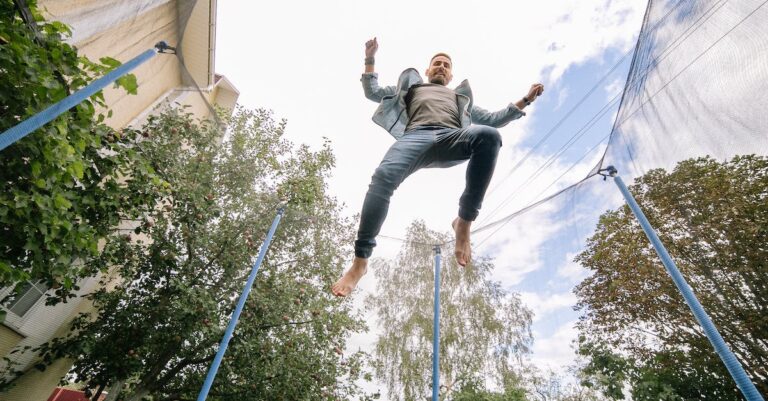Mastering Trampoline Skills: A Step-by-Step Tutorial
Introduction
What is trampolining?
Trampolining is a thrilling and exhilarating activity that involves bouncing and performing acrobatic movements on a trampoline. It is a popular recreational and competitive sport that offers a wide range of physical and mental benefits. Trampolining requires a combination of balance, coordination, strength, and flexibility, making it a great way to improve overall fitness. Whether you are a beginner or an experienced trampolinist, mastering trampoline skills is a rewarding journey that allows you to push your limits, learn new tricks, and experience the joy of defying gravity.
Benefits of trampolining
Trampolining offers a wide range of benefits for both children and adults. One of the main advantages is that it provides a fun and enjoyable way to stay active and fit. Jumping on a trampoline is a great form of cardiovascular exercise that helps improve coordination, balance, and agility. It also helps strengthen muscles, especially in the legs and core. Additionally, trampolining can have positive effects on mental health by reducing stress and improving mood. Whether you are a beginner or an experienced trampolinist, incorporating trampolining into your fitness routine can lead to a healthier and happier lifestyle.
Why learn trampoline skills?
Trampoline skills offer a wide range of benefits, making it a worthwhile endeavor to learn and master them. Firstly, trampoline skills provide a fun and exciting way to stay active and improve physical fitness. Jumping on a trampoline engages multiple muscle groups, including the legs, core, and arms, resulting in increased strength, balance, and coordination. Additionally, trampoline skills can enhance cardiovascular health, as the continuous bouncing action helps to improve endurance and stamina. Moreover, learning trampoline skills can boost self-confidence and self-esteem, as individuals progress and achieve new tricks and techniques. Finally, trampoline skills can be a great social activity, allowing for interaction and friendly competition with others. Whether you are a beginner or an advanced jumper, learning trampoline skills can bring joy, health benefits, and a sense of accomplishment.
Choosing the Right Trampoline

Types of trampolines
Trampolines come in various types, each offering a unique jumping experience. The most common type is the round trampoline, which provides a balanced bounce and is suitable for all skill levels. Rectangular trampolines, on the other hand, are preferred by advanced jumpers as they offer a higher bounce and more control. Oval trampolines combine the best features of both round and rectangular trampolines, providing a good balance between bounce and control. Lastly, square trampolines are known for their stability and are often used for gymnastics and professional training. Whether you’re a beginner or an experienced jumper, there is a trampoline type that suits your needs and skill level.
Size and shape considerations
When it comes to trampoline skills, size and shape considerations play a crucial role. The size of the trampoline determines the amount of space available for performing various tricks and maneuvers. A larger trampoline provides more room for jumps and flips, allowing for a wider range of skills to be mastered. On the other hand, a smaller trampoline may be more suitable for beginners or those with limited space. Additionally, the shape of the trampoline can also impact the type of skills that can be performed. Rectangular trampolines are often preferred by advanced users as they offer better control and stability, making it easier to execute complex moves. Circular trampolines, on the other hand, provide a more forgiving bounce and are ideal for beginners. Ultimately, understanding the size and shape considerations of a trampoline is essential for mastering trampoline skills and ensuring a safe and enjoyable experience.
Safety features to look for
When it comes to trampoline skills, safety should always be a top priority. Before you begin your trampoline journey, it is important to understand the safety features to look for. These features can help prevent accidents and injuries, ensuring a fun and safe experience. One important safety feature is a sturdy frame made of high-quality materials that can withstand the weight and impact of multiple users. Additionally, a safety net enclosure can provide an extra layer of protection by preventing users from falling off the trampoline. Other features to consider include padded springs and a thick, durable jumping mat. By investing in a trampoline with these safety features, you can enjoy mastering trampoline skills with peace of mind.
Basic Trampoline Skills

Bounce and landing techniques
In order to master trampoline skills, it is crucial to learn proper bounce and landing techniques. Bouncing on a trampoline requires a combination of control, balance, and coordination. When bouncing, it is important to keep your body centered and your weight evenly distributed. This will help you maintain stability and control throughout your jumps. Additionally, mastering the art of landing is essential for preventing injuries. When landing, aim to land with your feet first, followed by your knees and then your hands. This sequence helps absorb the impact and distribute the force evenly, reducing the risk of strain or injury. By practicing and perfecting your bounce and landing techniques, you can enhance your trampoline skills and enjoy a safer and more exhilarating experience.
Jumping and turning
Jumping and turning are two fundamental skills in trampolining. Mastering these skills is essential for any trampolinist looking to advance in their abilities. When jumping, it is important to maintain proper form and technique, using the legs to generate power and control the height and direction of the jump. Turning, on the other hand, involves twisting the body in mid-air to change direction or perform various tricks. Learning how to jump and turn effectively will not only enhance your performance on the trampoline but also minimize the risk of injury. In this tutorial, we will break down the steps to help you master these skills and elevate your trampolining game.
Knee drop and seat drop
In the world of trampolining, the knee drop and seat drop are two fundamental skills that every aspiring trampolinist must master. These skills not only showcase control and precision but also form the foundation for more advanced tricks and flips. The knee drop involves dropping to your knees on the trampoline bed, while the seat drop requires landing on your bottom. Both skills require proper technique and body positioning to ensure a safe and successful landing. By practicing these skills regularly and gradually increasing the height and difficulty, trampolinists can develop the necessary strength and coordination to perform more complex maneuvers. So, let’s dive into the step-by-step tutorial on how to master the knee drop and seat drop in trampolining!
Intermediate Trampoline Skills

Front and back somersaults
Front and back somersaults are advanced trampoline skills that require a combination of technique, strength, and coordination. These impressive moves involve flipping forwards or backwards in the air while maintaining control and landing safely on the trampoline. To master front and back somersaults, it is important to start with the basics and gradually progress to more advanced maneuvers. This tutorial will guide you through the step-by-step process of learning and perfecting these exciting trampoline skills. Get ready to take your trampoline skills to new heights!
Twists and spins
Twists and spins are advanced trampoline skills that require a combination of strength, coordination, and control. These dynamic movements add an exciting element to trampoline routines and can impress both spectators and judges. To execute twists and spins successfully, trampolinists must master the technique of generating rotational power from their core and using their arms and legs to control the direction and speed of the spin. It takes practice and perseverance to perfect these skills, but once mastered, they can elevate a trampolinist’s performance to new heights.
Pike and tuck jumps
In the world of trampoline skills, one of the most exciting and challenging techniques to master is the pike and tuck jumps. These jumps require a combination of strength, coordination, and precision to execute properly. The pike jump involves bending at the waist and bringing the legs straight out in front, creating a pike shape in the air. On the other hand, the tuck jump involves pulling the knees up towards the chest, creating a tucked position. Both jumps require a strong push off the trampoline bed and a quick and controlled movement in the air. Mastering these jumps is essential for advancing to more complex trampoline skills and routines. With practice and dedication, anyone can learn to perform impressive pike and tuck jumps on the trampoline.
Advanced Trampoline Skills

Double somersaults
Double somersaults are one of the most challenging trampoline skills to master. It requires a combination of strength, coordination, and timing. To perform a double somersault, the trampolinist must jump high into the air and tuck their body into a tight ball. As they reach the peak of their jump, they must quickly extend their body and rotate twice before landing back on the trampoline. It takes years of practice and dedication to perfect this skill, but with the right technique and training, anyone can learn to do double somersaults on the trampoline.
Layout and full twists
In the world of trampoline skills, layout and full twists are considered to be advanced techniques that require a great deal of practice and precision. A layout is a skill where the body is fully extended in a straight position, parallel to the trampoline bed. It requires a combination of strength, flexibility, and body control to execute a perfect layout. On the other hand, a full twist is a skill where the body rotates 360 degrees in the air before landing back on the trampoline. It requires a strong core, coordination, and spatial awareness to perform a full twist with ease and grace. Mastering these skills can take time and dedication, but with the right guidance and practice, anyone can become proficient in trampoline layout and full twists.
Combining multiple skills
Combining multiple skills is a crucial aspect of mastering trampoline skills. Once you have learned the basic skills, such as jumps and flips, it is important to start combining them to create more complex and impressive routines. By combining skills, you can create unique sequences that showcase your agility, coordination, and creativity. Whether it’s combining a front flip with a twist or a series of different jumps, the possibilities are endless. Practicing and perfecting these combinations will not only enhance your trampoline skills but also add flair and excitement to your performances.
Safety Precautions and Maintenance

Setting up a safe trampoline area
When it comes to setting up a safe trampoline area, there are a few important factors to consider. First and foremost, you’ll want to choose a suitable location for your trampoline. It should be on a flat, level surface away from any obstacles such as trees or fences. Additionally, it’s crucial to ensure that the trampoline is properly anchored to the ground to prevent it from tipping over during use. Another key aspect of creating a safe trampoline area is to have sufficient padding around the trampoline. This can help cushion any potential falls and reduce the risk of injuries. Lastly, it’s essential to establish clear rules and guidelines for trampoline usage, such as limiting the number of jumpers at a time and prohibiting risky maneuvers. By following these steps, you can create a safe and enjoyable trampoline area for everyone to enjoy.
Proper supervision and rules
Proper supervision and adherence to rules are essential when mastering trampoline skills. Trampolines can be a fun and exciting way to exercise and improve coordination, but they can also pose risks if not used correctly. It is important to always have a responsible adult present to supervise trampoline activities, especially when children are involved. Additionally, establishing and enforcing safety rules is crucial to ensure everyone’s well-being. This includes guidelines such as limiting the number of jumpers on the trampoline at a time, avoiding flips and somersaults unless properly trained, and using the trampoline on a level and clear surface. By following these precautions, individuals can enjoy the benefits of trampoline skills while minimizing the chances of accidents or injuries.
Regular maintenance and inspections
Regular maintenance and inspections are crucial for mastering trampoline skills and ensuring a safe and enjoyable experience. By regularly checking the trampoline’s frame, springs, and mat for any signs of wear or damage, you can prevent accidents and extend the lifespan of your equipment. Additionally, it is important to clean the trampoline regularly to remove dirt, debris, and any potential hazards. Regular maintenance also involves tightening any loose bolts or screws and ensuring that the trampoline is properly assembled and stable. By dedicating time to regular inspections and maintenance, you can create a safe environment for practicing and perfecting your trampoline skills.






